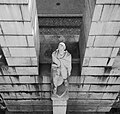| Prospect Terrace Park | |
|---|---|
 The park after 2018 renovations | |
 | |
| Location | College Hill, Providence, Rhode Island |
| Coordinates | 41°49′47″N71°24′25″W / 41.8298224°N 71.4070008°W |
| Created | 1869 |
Prospect Terrace Park is a park located on Congdon Street in the College Hill neighborhood of Providence, Rhode Island. The park was founded in 1869, on land that was given to the city by residents of the neighborhood. [1] [2] The park is known as "The Jewel of the City" [3] for its dramatic elevated view of Downtown Providence.
Contents
Author and Providence native H. P. Lovecraft frequently visited the park. [4]







